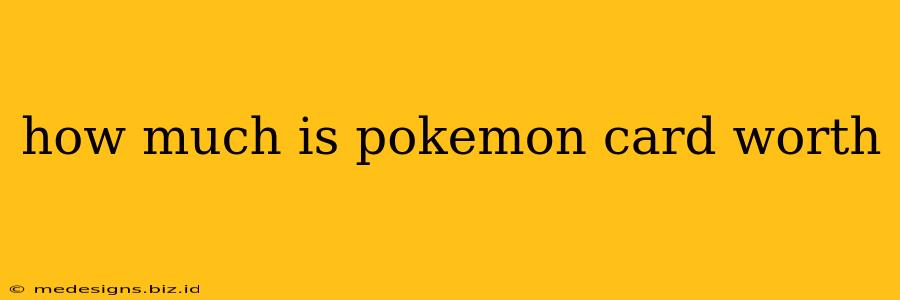So, you've unearthed a Pokémon card from your childhood, or maybe you're a seasoned collector adding to your impressive stash. The burning question: how much is this Pokémon card worth? Determining the value of a Pokémon card isn't always straightforward, but this guide will walk you through the process, helping you accurately assess its worth.
Factors Affecting Pokémon Card Value
Several key factors influence a Pokémon card's price. Understanding these is crucial for accurate appraisal:
1. Rarity:
This is arguably the most significant factor. Pokémon cards are categorized into different rarities, including:
- Common: These are the most plentiful cards.
- Uncommon: Less common than common cards.
- Rare: Less frequent than uncommon cards.
- Rare Holo: Rare cards with holographic foil.
- Ultra Rare: Extremely rare cards, often featuring powerful Pokémon or artwork.
- Secret Rare: The rarest of all, usually with unique artwork or special effects.
The rarer the card, the higher its potential value.
2. Condition:
The condition of your card significantly impacts its worth. Even a rare card in poor condition will be worth considerably less than a pristine example. Consider these aspects:
- Centering: Is the artwork centered perfectly on the card? Off-center cards are worth less.
- Edges: Are the edges crisp and clean, or are there scratches or dents?
- Corners: Are the corners sharp and undamaged? Rounded or damaged corners significantly reduce value.
- Surface: Are there any scratches, creases, or blemishes on the card's surface?
Grading services, such as PSA (Professional Sports Authenticator) and Beckett, offer professional grading and authentication, which dramatically increases a card's value.
3. Card's Popularity & Demand:
Certain Pokémon cards are simply more popular than others. Highly sought-after Pokémon (like Charizard, Pikachu, Blastoise, and Venusaur) command higher prices, even for common cards. Furthermore, cards from popular sets (like Base Set, Team Rocket, or Celebrations) are generally more valuable.
4. First Edition Status:
First edition cards are always worth more than their non-first edition counterparts. The "1st Edition" symbol on the card signifies its rarity and collectible value.
5. Errors and Variations:
Printing errors or variations can significantly increase a card's value. These are incredibly rare and highly sought after by collectors.
How to Determine Your Pokémon Card's Value:
- Identify the card: Determine the Pokémon, set, and rarity.
- Assess the condition: Carefully examine the card for any imperfections. Consider using a grading scale to help you quantify the condition.
- Use online resources: Several websites and apps specialize in Pokémon card pricing. These resources often have databases with pricing information based on condition and rarity. Compare your card to listings with similar conditions.
- Check auction sites: Sites like eBay can provide a good indication of current market prices. Pay attention to completed listings to get a sense of what similar cards are selling for.
- Consider professional grading: For valuable cards, professional grading can provide an objective assessment of condition and significantly increase resale value.
Beyond Monetary Value:
While the monetary value is important, remember that the sentimental value of a Pokémon card can be immeasurable. A card that holds personal significance might be priceless, regardless of its market value.
This guide should provide you with a strong foundation for assessing your Pokémon card's value. Remember, research is key to accurate pricing. Happy collecting!
